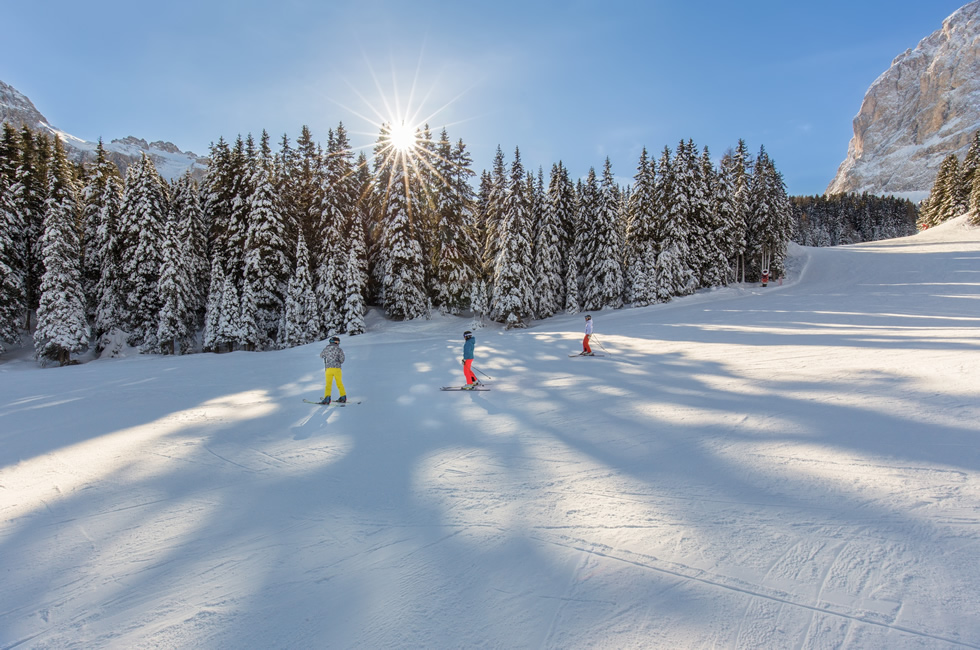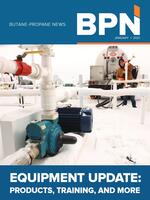
Bruce Whitney, executive director of the New York Propane Gas Association, developed an appreciation for propane at a young age. Back then, it wasn’t about all of the ways propane benefits his association members throughout New York these days. “As a teenager, I worked on Ski Patrol and at the lift house at the top of the mountain at a small but very steep ski area in Vermont called Dutch Hill,” he explained. “When the propane ran out to heat the tiny shack that housed the person responsible for the T-Bar lift, my job at that 4- by 6-foot uninsulated hut got colder and colder.” Whitney was at the mercy of another member of the ski area team to get a 100-lb tank of propane. “That propane delivery was also going to come from my dad, the operations guy, and he figured I could tough it out until he had a free moment to get a tank of propane to the top of the mountain, usually after he was done operating the snow cat grooming the new powder that seemed to fall every night. When I look back, all those late nights skiing alone in new powder snow in the headlights of my dad’s snowcat made that top shack work worthwhile.” He went on in jobs from testing equipment, coaching and training coaches and staff in skiing and snowboarding, to becoming vice president of two ski companies.
“I was a teenager and developed a respect for propane on those really cold days in the ‘70s back when we had real winters!” Whitney said. “With the fashionable push to electrify everything nowadays, I can’t imagine relying on electricity and having winter brownouts and blackouts caused by new peak usage demands as well as storms where you might wait for days and days to get electric heat back in a cold winter. Life would not be good at a ski resort or most anywhere in New York for that matter.”
Last March, COVID-19 became a new factor and it continues to be tough on New York. With by far the highest number of cases early on, as the pandemic hit the U.S., New York got most cases under control. But this was at the expense of most restaurants and businesses operating with occupancy at 50% of capacity, which is the current policy for ski resort lodges. More recently, in mid-November, schools in New York City closed their doors again as cases ticked back up, and in mid-December, New York City restaurants were ordered to discontinue indoor dining indefinitely by Gov. Andrew Cuomo.
For many restaurants, propane heaters for outdoor dining continued to be a lifeline as thousands of restaurants were concerned the pandemic may cause them to shutter their doors for good. “A little more under the radar, but heavy users of propane in New York, ski resorts are open for business and are using more propane than ever to keep socially distanced skiers warm when taking a break on the slopes.” Whitney said.
Before joining the propane industry, Whitney spent nearly 30 years of his career in various roles in the ski resort industry. “Skiing is a sport where you control your speed and enjoy the environment. As I have told my daughters in all of their sports, the better you are at it, the more fun it is,” he said. “Kids are funny. If they are having fun, they don’t seem to get cold so quickly and they don’t want to go inside. I learned that in many years of coaching. Nonetheless, when they do, a hot chocolate always tastes especially good in a heated lodge after all that fun in the cold!” Almost every ski resort in New York runs heavily on propane, according to Whitney. “These lodges have especially high ceilings. Electric heat would not be adequate to keep these lodges warm. The cost to try would be expensive,” he said.
NEW YORK HAS MORE SKI RESORTS THAN ANY OTHER STATE
New York is the fourth largest skiing state in the U.S., behind Colorado, California, and Vermont, according to Scott Brandi, president of Ski Areas of New York. “But New York has 50 ski areas, the most of any state, and they range in size from very large to small mom-and-pop facilities,” he said. “Propane is a big player in keeping our ski areas going. Resorts are adding portable heaters, which have been hard to get but we started working on it early. They have added portable buildings to have alternate shelters, and they are encouraging people to accept that the social part of skiing will need to be different this year.” The lodges will not be for socializing as much this year as they can’t accommodate as many people. “People are being encouraged to also use their cars as a place to warm up. Box lunches and sack lunches will be more common this year as they take a break to eat and rest during the day,” Brandi said.
AT WINDHAM MOUNTAIN RESORT…
Chip Seamans, president/general manager at Windham Mountain Resort in Windham, N.Y., said less capacity at the base lodge has meant adding more options beyond the sit-down restaurant, the cafeteria, and the club.

“We’re having to reduce the number of people in the base lodge at one time as well as the number on the mountain on peak days,” Seamans said. “We’re adding food trucks on the patio as well as heaters and firepits, which are nice to stand around. In addition, three heated benches just like the NFL uses are in place. These put out heat on the feet and back of the seats. All of this requires a lot more propane.”
“With more people working at home, we are seeing more people during the week,” Seamans explained. “Unfortunately, not as many people can hang out in our restaurants and bars. They’re doing more outside. In order to avoid overcrowding we are no longer selling season passes and ticket sales are limited to a certain number each day. Seamans added that they are happy with Nolan Propane and Sons (Ravena, N.Y.), their propane provider. “They are great to work with and have provided us our own filling station for tanks. They have even paid to sponsor one of our propane benches and have their name on it.”
AT HOLIDAY VALLEY RESORT…
At Holiday Valley Resort in Ellicottville, N.Y., all lodges use natural gas, but the new warming hut at the top of the hill, the Cindy’s Overlook, and one of the lift houses are heated with propane. “The Holiday Valley Tubing Co.’s base lodge also uses propane,” said Jane Eshbaugh, director of marketing. “We will be erecting tents this winter for additional socially distant seating outside our lodges, which will have propane heaters.”
Crabb Oil and Propane, a division of NOCO Energy, handles propane supply for both the Holiday Valley Resort and the Holiday Valley Tubing Co. “They installed a 1000-gallon underground tank at the warming hut and we have smaller tanks if needed,” said Steve Crowley, director of operations. “They work with us to keep track of our energy needs. They are onsite regularly as needed and always wear masks and follow COVID-19 protocol.”
AT PLATTEKILL MOUNTAIN…
Near Plattekill, N.Y., Laszlo Vajtay took a break from making snow at Plattekill Mountain where he is president/general manager to talk with BPN about preparations for the ski season. “COVID-19 has caused a lot of spending on the property, including enclosing the outdoor food vendors and putting overhead heating systems to keep employees warm,” Vajtay said. “Food and drinks are served through a window. There is plexiglass all around the deck.”
This new setup is allowing them to limit the lodge to the 50% capacity requirement. “The lodge experience is moving to cars this year often with bag lunches,” Vajtay said. “Unlimited passholders have first priority here. We have online sales for day passes and can limit the number of skiers on peak days if needed.”

Vajtay noted that he is pleased with his propane provider, Paraco Gas, as well as the work of Mike Taylor of Combined Energy Solutions, who designed and installed the propane infrastructure at Plattekill Mountain.
AT STATE-OWNED WHITEFACE, GORE, AND BELLEAYRE MOUNTAINS…
Like Whitney, many who continue to work in and lead the ski resort business found their passion for the ski industry at a young age. After the USA hockey team defeated Finland to win the gold metal at the 1980 Winter Olympics at Lake Placid, N.Y., a random guy in a red hat was in the background of an iconic celebratory photo. At that time, the random guy, Mike Pratt, was a maintenance guy at the ice rink; today he is president and CEO of the Olympic Regional Development Authority (ORDA), the organization created in 1982 to protect the state’s investment made to host the 1980 winter games.
Today, Pratt’s challenges are greater than cleaning up the ice rink; his state-owned corporation oversees the ski areas at Whiteface Mountain, Gore Mountain, and Belleayre Mountain, in addition to the Olympics complexes, thus making the state government the biggest player in New York ski resorts. COVID-19 is the latest challenge for Pratt and his team.
Vero Piacentini, ORDA’s vice president of operations, told BPN that propane is in use as much as ever. “We’ve switched from fuel oil to propane in recent years at more and more of our areas and COVID-19 has required more tents with propane heat. We did have to turn off the propane firepits, though, as they were causing people to congregate too close together.”
ORDA officials shared their published policies with BPN, and note their team is undergoing a daily health screen prior to every shift, and following guidelines recommended by New York State and CDC.
For the opening weekend of Dec. 4-6, access to the mountain was limited.
SKIING AROUND THE U.S.
Of course, policies and procedures can change as the entire country enters the coldest months of winter amid the strongest wave of coronavirus to hit the U.S. In the largest skiing state in the country, Colorado, a 2015 study pegged the economic contribution of the skiing industry at $4.8 billion, supporting more that 46,000 workers. The state alone accounts for 22% of the nation’s winter sports economy. In Colorado, county health officials are working closely with all ski resorts in their jurisdiction with operational levels tied to COVID-19 infection rates in the community.
In California, skiers are encouraged by Ski California member resorts to “Know Before You Go” and review each resort’s COVID-19 policies. All resorts are requiring face coverings whenever physical distancing cannot be achieved.
In Vermont, there was early excitement that fewer people traveling internationally or domestically by air due to COVID-19 would make Vermont a great alternative for Northeast U.S. ski enthusiasts. Then a recent tightening of quarantine rules by Gov. Phil Scott for anyone visiting the state presented a challenge. Travelers either had to commit to a 14-day quarantine (at home or in state), or a quarantine of seven days followed by a negative COVID-19 test. Furthermore, many areas of Vermont moving to a color code of red signaled more cases and further deterred skiers causing a steady stream of travel cancellations. Ski Vermont also encourages skiers to “Know Before You Go,” reviewing resort COVID-19 policies, be prepared for lodge capacities as low as 30%, be prepared for 30-minute limits on time in the lodge, and plan to use your car as base lodge.
Despite all the different COVID-19 policies and procedures across the United States, there seem to be a few constants: skiers are adapting to the various rules, propane is playing a big role in keeping skiers warm, and as one Vermont skier noted on opening day, despite all the changes, “You won’t find anyone here without a smile today. You know they’re smiling under their masks.” — Pat Thornton


